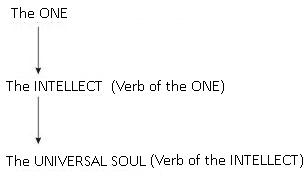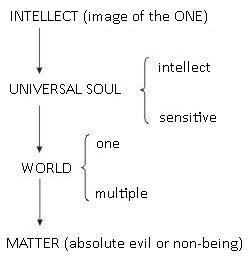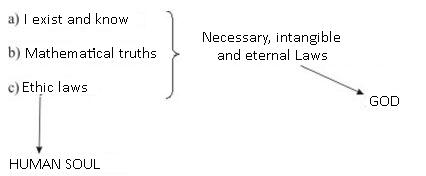Neoplatonists
‘Neoplatonism’ was the last serious attempt to revive Plato's philosophy in the Christian Era. This philosophy, which mainly pointed out the mystical-religious aspects of Platonic thought, coexisted with Christianity for a long time. It extinguished at the same time as the definite fall of the Roman Empire or, in other words, with the fall of the 'Ancient World'. It developed in 3 stages:
- Roman-Alexandrian (II and III centuries) – PLOTINUS
- Syrian (IV and V centuries) – IAMBLICHUS
- Athenian (V and VI centuries) – PROCLUS
Plotinus (204-270)
The ‘first beginning’, for Plotinus, was, as for other thinkers, even previous to Plato, the ONE or the Good, which shares characteristics with the 'being' of Parmenides and the 'God' of Philo:
- Absolute simplicity
- Self-sufficient
- Transcendent to every determination (to the being and the essence)
- Infinity
- Pure act, self-creator.
Every being comes from the One through the following process of emanation:
- The ONE, power of everything
- The generation of beings doesn't happen due to necessity, but due to transcendence.
- Omnipresence and omnipotence of the ONE
- The '3 Hypostasis' (NEOPLATONIC TRINITY):

Similar to Philo, Plotinus makes everything created from the 'Intellect' emerge through several levels of descent:

When applied to the human being, we find that for Plotinus, the true being of man is the soul and the transcending reason.
Therefore, ‘sin’ would consist in the adhesion to corporeal things and the separation of spirituality, while ‘virtue’, on the other hand, would consist in the purification of the soul, given that " only a beautiful soul can contemplate what's beautiful".
Plotinus considers that there are 3 paths to spiritual elevation: MUSIC, LOVE and PHILOSOPHY. As you can see, it is a sophisticated and mystical version of the 'theory of ideas' of Plato. It is quite influenced by those ideas of Alexandrian Jewish thinkers: Philo, etc.
The result of this blend is quite similar to the ideas of Christianity, and this might explain why this philosophy was so tolerated for so long, clearly being a pagan philosophy. As we will see later, it was even assimilated by christian thinkers, such as St. Augustine, for example.
Augustine of Hippo (St. Augustine, 354-430)
The Thought of St. Augustine goes through four stages, according to the influences it received:
- Manichaeism (human reasoning can make men wise by itself)
- Skepticism (neo-academism)
- Neoplatonism (Plotinus, Porphyry )
- Christianity (FAITH)
According to St. Augustine, ‘wisdom’ was the goal in life. For this reason, he went to different philosophical schools of that time until he found the one he thought to be best for his purposes. According to him, only Neoplatonic thinking adjusted to the conditions he demanded, but always with the support of Christian Faith.
As a result, wisdom was defined by two components: HUMAN REASONING (Neoplatonism) and the AUTHORITY OF CHRIST (mystical experience of God, through the study of the Sacred Scriptures).
The problem of certainty
According to neo-academics (successors of the Platonic Academy in the times of St. Augustine, due to the fact the senses lie to us, a full level of certainty was impossible; in other words, they had reached the level of skepticism.
Meanwhile, St. Augustine suggested that an absolute doubt was contradictory, since at least, we were sure that we were and that we were able to think. This was the first statement in the history of philosophy which would, in later centuries, be known as ‘Cartesian Cogito’.
As a fact, the same as Socrates and later Descartes, St. Augustine chose INTERIORISM: the act of knowing goes inside, towards oneself, and not outwards, towards material things. What he discovered studying himself, were three things:

This discovery of the ‘human soul’ allows St. Augustine to make a definition of MAN which coincides, of course, with those proposed by Plato and Plotinus: a rational soul which uses an earthly and mortal body.